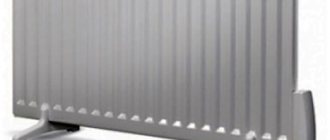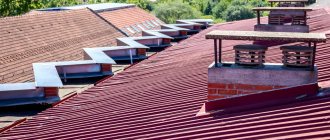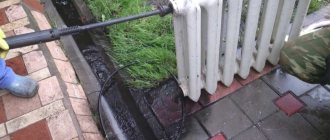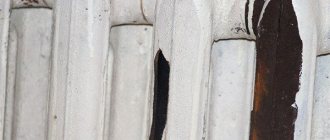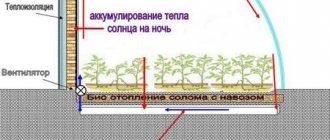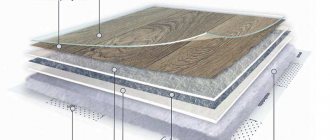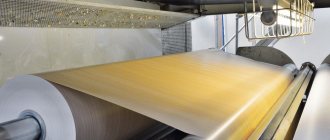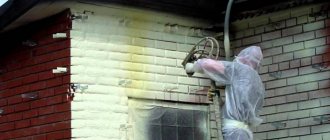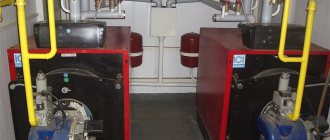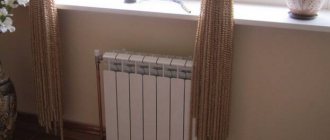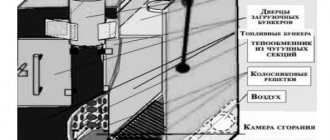Today we will try to figure out the question of how to choose linoleum for your home in terms of quality and reasonable price from the variety of options that building materials stores offer us.
Linoleum still remains one of the most affordable and popular floor coverings, so the topic is relevant.
I hope that this article will help you not to succumb to advertising tricks and, guided not by your own emotions, but by the information received, make the right choice.
If you are bored reading about the types, types and technical characteristics of linoleum, then you can immediately move on to the fifth paragraph of the article. There you can read useful recommendations directly on choosing linoleum.
The best semi-commercial foam-based linoleum
Semi-commercial linoleum Tarkett Magia Viva is quite a bit different from commercial linoleum. He is not afraid of heels and furniture legs. It is mainly used in rooms with a large influx of people.
The service life depends on the insulating base. The foam base is used in multilayer linoleum.
Its structure consists of several layers:
- The top one is protective. This is a PVC layer that prevents the design from being erased.
- Finishing, plain or with a pattern.
- Basis for drawing.
- Fiberglass, which increases strength, reliability and prevents the material from deforming.
- A layer of foamed polyvinyl chloride.
- The bottom one with all the markings.

Pros:
- Warm.
- Waterproof, easy to clean.
- Hides small unevenness and cracks in the floor.
- It is suitable for rooms with high traffic and can withstand heavy loads.
- Easy to install.
- Withstands high temperatures and does not rot.
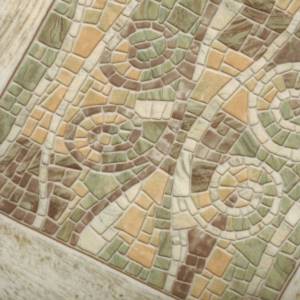
Minuses:
- It is not advisable to lay it in a children's room.
- It is sensitive to temperature changes and shocks.
- It cannot be classified as an environmentally friendly material.
Types of linoleum
Linoleum is distinguished by material, base and area of application. We will review each type to help you choose the right floor covering.
By material
The flooring product is made from various synthetic and natural materials. This allows you to select and lay linoleum that suits the conditions in a particular room.
Natural material
Linoleum made from natural material is environmentally friendly. It has antistatic and wear-resistant properties. Resistant to fire, fats and various reagents. You won't be able to choose a color to match the interior. Coatings made from natural ingredients are produced in one color.
The composition includes the following components:
- pine tree resin,
- flax oil,
- lime powder,
- wood flour,
- natural dyes.
Important! High humidity is contraindicated for a natural product. It should not be bent because it breaks easily.
PVC
Polyvinyl chloride (PVC) flooring is made from polyvinyl chloride with the addition of various dyes. PVC products can be homogeneous or heterogeneous.
Homogeneous PVC linoleum contains one layer, which includes a base, a backing and a protective layer. Heterogeneous is a multilayer coating. It consists of a base, middle, strengthening and top layers. Each layer is fixed with PVC paste.
PVC material has the following advantages:
- Resistant to moisture, wear, and fading.
- Available in a varied color palette.
- It has an optimal price category.
Among the disadvantages of PVC linoleum is a slight smell of synthetic components, which disappears after a few days. And also the high fire hazard of the floor product.
Colloxylin
This material is used in places with high humidity. It contains nitrocellulose, dyes, and mineral additives. Such flooring products have good flexibility and a wide range of colors. At the same time, they are very thin to the touch and do not have a base. Disadvantages: rapid flammability, low frost resistance.
Important! Colloxylin floor covering is allowed to be used only in industrial premises.
Alkyd
An alkyd product consists of alkyd resin, additives and pigments. The composition is applied to a fabric base. Linoleum has good sound and heat insulation qualities and high wear resistance. Used in warehouses and offices.
Disadvantages of alkyd material:
- at low temperatures, shrinkage and cracking occur;
- lack of elasticity;
- is fire hazardous and releases toxic substances when burned.
Relin
Relin or rubber linoleum consists of two layers. The bottom layer is made of crushed rubber or bitumen. The top layer is rubber with various additives. This layer is made in relief to reduce the sliding properties of the surface. This coating is elastic, moisture-resistant, frost-resistant, and durable. Relin is used in public places: elevators, airports, hospitals, train stations.
Based on
The base of linoleum is the lowest layer that meets the floor. Thermal and sound insulation, strength, and service life of the product depend on the base. The base helps hide uneven floors.
Linoleum without base
Material without base – thin floor covering no more than 2 mm thick. This product does not have heat or sound insulating properties. Can tear quickly on uneven floors. It can only be laid on a perfectly flat heated floor or chipboard. The advantage of baseless linoleum is its general availability.

Foam base
Foamed PVC base is most convenient to use. Coating thickness – 1.5 – 3.5 mm. You can lay such material in any room. The foam base has the following advantages:
- moisture resistance - ideal in the bathroom, kitchen, hallway;
- resistance to mechanical loads, punching - quickly restores its original appearance;
- long service life - an average of 10 years.
High temperatures are harmful to the PVC base. It loses all its positive properties at temperatures above 26 ℃. Therefore, this product is not used on heated floors.
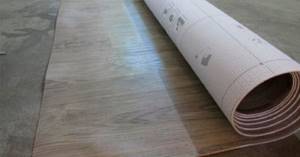
Felt base
Linoleum on a felt or fabric basis is the thickest and most environmentally friendly. Its thickness is on average 5 mm. It has good sound and heat insulation. Suitable for dry, warm rooms with uneven floors. In this case, the material shrinks slightly. And is not able to recover from various pressures.
Today, the felt base is impregnated with special compounds. They help fight felt rotting. Still, you should refrain from using felt-based products in cold and damp rooms.
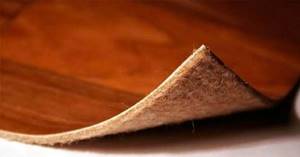
By area of application
The area of application of flooring is divided into several types. This is determined by the purpose of the place where the material will be used.
Domestic
Household linoleum is used to cover floors in apartments and houses. It consists of several layers. It can be baseless or on a foamed PVC base. The thickness of the protective layer is up to 0.35 mm. This material is easy to care for. It comes in a variety of colors and low prices.
In domestic premises, the second class of linoleum is used. It has the following classification:
- 21 – used in places with low mechanical load – bedrooms, storage rooms, dressing rooms;
- 22 – used in places with average mechanical load – children’s rooms, living rooms;
- 23 - used in places with high mechanical load - corridors, kitchens, halls.
Semi-commercial
Semi-commercial coverings are laid in public spaces, offices, and homes. The structure of a semi-commercial flooring product is similar to a household one. But it has a thicker protective layer of up to 0.7 mm, which increases its wear resistance.
In semi-commercial premises, the third class of linoleum is used. It has the following classification:
- 31 – used for public places with low mechanical load – hotel rooms, boss’s office;
- 32 - used for places with medium mechanical load - school classrooms, preschool institutions, medical institutions;
- 33 - used for places with high mechanical load - school corridors, large offices;
- 34 - used for places with increased mechanical load - shopping centers, train stations, cinemas.
Commercial
Commercial flooring is characterized by a long service life, high wear resistance, and non-flammability. This material is not afraid of various pressures from shoes, furniture legs and equipment. The protective layer has a thickness of 0.6 mm.
In commercial premises, the fourth class of product is used. It has the following classification:
- 41 – used for public places with low mechanical load – sewing workshop, electrical equipment repair shop;
- 42 - used for places with medium mechanical load, where work is performed standing, and equipment is occasionally used - warehouse, repair area;
- 43 - used for places with high mechanical load, where special equipment is used and high traffic intensity - large industrial areas.
Special
Floor coverings made for specific purposes are called special. Special linoleum can have the following varieties.
- Sports. Polyurethane is used as a protective layer. It increases the product's resistance to wear and contamination. The bottom layer is made of foamed PVC. This allows you to soften the impact of a fall and increase the elasticity of the coating.
- Antibacterial. The protective layer has antimicrobial properties. This material is used in laboratories, kindergartens, and medical institutions.
- Antistatic. The material obtains such properties by adding graphite to its composition. The area of application of the coating is rooms with electronic equipment, server rooms.
- Stage. Has a matte top layer. This makes it possible to obtain the necessary light balance on stage. The material contains PVC, surface additives that impart plasticity, and various dyes. These products are also used in ballet and dance classes.
- Wall. It is used to seal walls in hospitals in the food and pharmaceutical industries. The wall covering is resistant to various damages.
- Anti-slip. The floor covering contains special additives in the surface layer: quartz chips, metal granules. A non-slip surface is also obtained due to the relief of the top layer. This material is used in places where various liquids may get on the floor. These are kitchens, swimming pools, cafes, shops.
The best semi-commercial linoleum for the kitchen
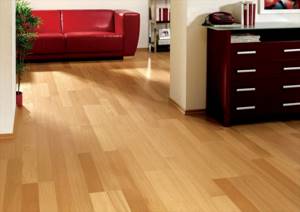
Tarkett Sinteros can withstand heavy loads. Installation does not require special knowledge and skills: you just need to lay it on the floor and let it lie for a day.
Advantages:
- Affordable price. Its cost is much lower than that of tiles or other coatings.
- Quality. It withstands animal claws and does not leave holes in furniture.
- Heat resistant and waterproof.
- Strength. It lasts a long time because it consists of several layers.
- Soundproofing. Prevents noise from spreading in the room.

Flaws:
- Synthetic base. If there are people in the family who suffer from allergies, it should not be laid.
- Sometimes it is necessary to treat with a special mastic.
Which linoleum is better to choose for an apartment - domestic, commercial or semi-commercial?
There is no specific and uniquely correct answer to this question. If we start talking about household linoleum, then, as the name suggests, it is used mainly only in residential areas.
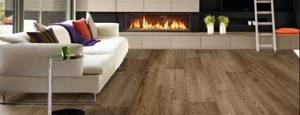
Among the advantages in it are the following:
- Economical. It has a very attractive price.
- Very easy to care for. You don't need any expensive special equipment.
- As we stated, it has a rich color palette.
- Very elastic and easy to transport.
- It insulates the room well.
- Has good moisture resistance.
As for the semi-commercial option, it is worth saying that it is something between the household and commercial options. It can be installed in moderate traffic areas, which basically means you can install it if you have a large family home. It has almost the same advantages. It's just a little more expensive.
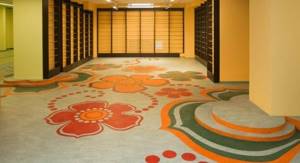
It’s up to you to decide which linoleum is best to lay, commercial or semi-commercial, or household. All options are well suited for home use. The last thing that could be noted is that when choosing household linoleum you still have great freedom in terms of color and type of coating (there are those imitating wood, parquet and others).
Commercial linoleum is not often used for laying on apartment floors, because... its cost compared to household and semi-commercial types is very high. If your budget for repair costs is “rubbery,” then this is a pretty good option for flooring that will easily serve you for more than 10 years without any jams, creases, etc.
The best antistatic semi-commercial linoleum

Antistatic coating Top Exstra is well suited for various substrates and has a wide range of applications.
Advantages:
- Does not require effort in installation and operation.
- A price accessible to every client.
- Resistant to impacts and abrasion.
- Moisture-resistant and resistant to all chemical compounds.
- Non-slip surface.
- Fireproof.
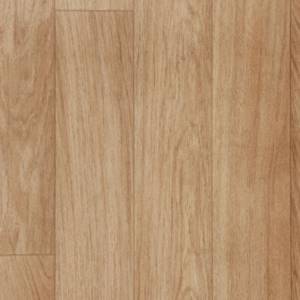
Flaws:
- In most cases, a synthetic base.
- To extend its service life, sometimes the flooring requires treatment with a special mastic.
Is it possible to paint linoleum and with what paint?
It just so happens that not everyone has the opportunity to immediately re-cover the entire coating after defects appear on the linoleum. Most resort to cunning methods. One of them is painting. Let's say straight away - linoleum can be painted. Another question is what coloring composition should I use to make sure it doesn’t turn out worse?
The most popular paints for linoleum are oil, alkyd and acrylic options. With them in order:
- Oil paints are the most budget option. If you follow the dynamics of development of the construction market, then this paint is already outdated. But it fits well on the surface and does not create unevenness. The only downside is the rather sharp and unpleasant odor during painting and during the drying process. This paint also needs to be renewed periodically, as it wears off over time.
- Alkyd paints are much more advanced, unlike the oil version. This paint is very elastic, resistant to water and is distinguished by its durability. It also does not fade in the sun. Dries quite quickly (in just a couple of hours). The only negative is that, like the oil version, it has a pungent odor when painting.
- Acrylic paints are the most suitable option for linoleum. Dries quickly and withstands mechanical damage well. The service life of such paints is very long. One of the nice little things is that the paint composition withstands chemical attack well (especially useful when you need to wash the floor with various means).

As we were able to find out, linoleum can be painted. The approach to paint depends only on the size of your budget. Of course, if it is not large, then oil paints are suitable for you; if it is medium or good, then alkyd and acrylic paints. But practice shows that it is better to pay money once for good material than to spend a lot of money later on redoing the work.
The best semi-commercial linoleum without a base
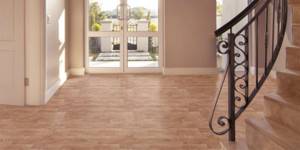
Juteks Optimal Bourbon is very thin - its thickness is no more than 1.6 mm. On baseless linoleum, the pattern is located throughout its entire thickness, thanks to which it does not wear out.
Advantages:
- Does not require experience or effort in installation.
- Waterproof.
- Suitable for rooms with high traffic volumes.
- Withstands impacts, wheels from gurneys, and does not leave marks from furniture.
- It is soundproofed.
- Affordable price.
- Has a range of colors to suit every taste.

Flaws:
- If it is not covered with special mastic, its service life will be 5-7 years.
- It doesn't retain heat.
The best semi-commercial heterogeneous linoleum
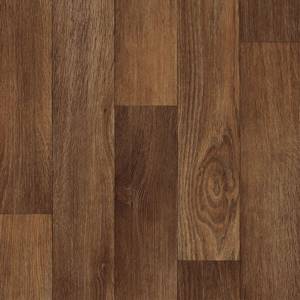
Alex-3 LUX has a more complex base. It has a service class of 33 with a protective layer of 0.15 mm. The structure reaches six layers, the thickness of the homogeneous coating is 2 mm. The width of flooring rolls reaches 1.5-5 m.
Advantages:
- Reasonable price.
- Waterproof.
- Does not require special knowledge for installation.
- It is soundproofed.
- Long service life.
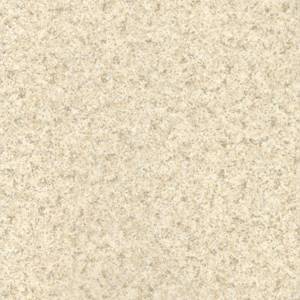
Flaws:
- Synthetic base.
- To extend the service life, the floor covering must be treated with a special mastic.
Important points before purchasing
Before you buy linoleum, you need to pay attention to several important points. Let's look at them.
Width and length
Measure the width and length of the room at several points in the room, hallway or kitchen. Select the highest result. To the initial data, add approximately 10 cm for uneven walls, recesses, protrusions, and for connecting the pattern. Be sure to measure the doorway so you don’t have to deal with joining the pieces later.
It is advisable to buy a piece of linoleum according to the width of the room. This way you will avoid unnecessary seams and joints. Today, manufacturers offer flooring widths from 1.5 m to 5 m. Therefore, you can easily find a suitable piece of the required size.
Pattern and color
Look at the drawing. It must be clear. An indicator of quality is also the uniform placement of the print over the entire surface of the material. It is advisable to buy pieces of the required sizes from one roll to avoid differences in tone.
It is important to consider the color layer so that it harmonizes with the rest of the room's shades. A cover with a small print is suitable for a small room. A product with an abstract image will transform a large room. A bright, cheerful pattern is most suitable for a children's room.
Smell
As strange as it may sound, smell the linoleum. A sharp, unpleasant odor will indicate a poor-quality coating composition. You should refuse to purchase such material. A good quality product smells practically nothing, even from synthetic components.
Abrasion
Check the markings of the selected coating for abrasion. This indicator will tell you how quickly the top protective layer of the product will be erased. In accordance with the standard, 4 types of abrasion are distinguished.
- High abrasion. Indicated by the letter F. The flooring material is made from cheap components. The wear of the protective layer reaches a thickness of 0.6 mm.
- Average abrasion. Indicated by the letter M. The flooring product is made of higher quality components than the material with the letter F. The wear of the protective layer reaches a thickness of 0.3 mm.
- Low abrasion. Indicated by the letter P. The floor covering is made of durable materials. The wear of the protective layer reaches a thickness of 0.15 mm.
- Abrasion tends to zero. Indicated by the letter T. The flooring product is made of high-strength components. The wear of the protective layer reaches a thickness of 0.08 mm.
Adviсe
It is recommended to purchase flooring in specialized stores. There you can ask the seller for a hygiene certificate for the material. This certificate shows that the linoleum has been tested and meets safety standards.
The best homogeneous semi-commercial linoleum

Jutecs Falco is produced in strength class 33 with a protective layer of 0.2 mm. Its pattern is applied to the entire thickness of the PVC. It is made of solid fabric with the addition of PVC granules and dyes.
Advantages:
- Easy to install, does not require special knowledge or effort.
- Reasonable price.
- Waterproof.
- Soundproofing.
- Withstands heavy loads.

Flaws:
- The width of the roll is 2 m; if the room is a little wider, you will have to cover the floors with a seam.
- If it is not treated with special mastic, its service life will become shorter.
The best semi-commercial linoleum for home

Semi-commercial linoleum for home Tarkett Idyll Nova CHARLSTON consists of five layers:
- PVC, which is responsible for quality.
- Pattern layer.
- A polyurethane layer that creates a durable base, sound insulation and waterproofing.
- The frame throughout the entire structure is fiberglass. Then the remaining layers are attached to it.
- The backing is made of foamed PVC; felt or jute is less common.
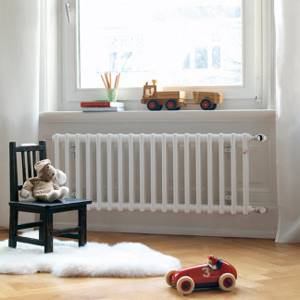
Advantages:
- Long service life.
- Reasonable price, accessible to everyone.
- Keeps warm well.
- It has excellent sound insulation, absorbs steps and noise.
- It is easy to care for and can be easily placed on the floor.
Flaws:
- Synthetic base.
- If it is not treated with special mastic, its service life will be shortened.
Which linoleum is better to lay on a concrete floor?
Since a concrete floor is an inhospitable, cold covering, when choosing linoleum you should give preference only to multilayer options with a foamed and insulated base.
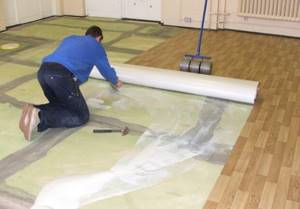
Why only this type? If you choose any other linoleum, then, of course, it will also fit well on concrete, but all year round you will notice that the floor is cold. This can have a major impact on your health.
The best semi-commercial linoleum with a protective layer of 0.5 mm
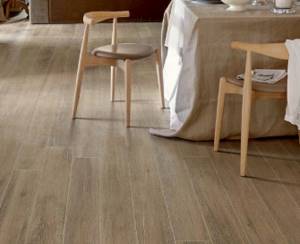
To increase the strength of the flooring, Tarkett Pastoral Nelson adds some useful substances to the protective layer:
- EXSTREME PROTECTION – increases strength up to seven times.
- TITANIUM is added for an additional varnish layer.
- TUREX gives the pattern a natural effect.
Semi-commercial linoleum "Pastoral Nelson" is recommended to be joined at the joints by cold welding.
Advantages:
- Reasonable price.
- After installation, a minimal amount of waste remains.
- Has good thermal insulation and sound insulation.
- Quite a long service life.

Flaws:
- Synthetic base.
- To increase its service life it must be treated with a special mastic.
Wall coverings
PVC wall coverings are suitable for rooms where there are increased requirements for hygiene, moisture resistance and tightness of surfaces: healthcare facilities, bathrooms, etc. Firstly, PVC itself is a material that does not promote the development of bacteria and microorganisms. In addition, it is moisture resistant and can be washed. And secondly, the use of hot welding during installation allows you to hermetically connect the canvases to each other, both on the wall and at the junction with the PVC floor covering. A sealed, properly welded seam will not allow water to penetrate under the coating and will not serve as a place for dirt to accumulate.
The best semi-commercial linoleum with a protective layer of 0.7 mm
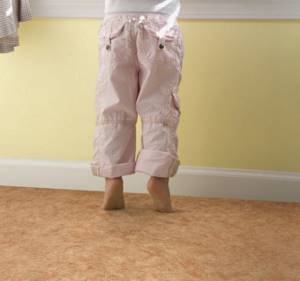
Tarkett Force with a protective layer of 0.7 mm, insulated on a foam base, 2.5 mm thick.
If you look at it in cross-section, you can see six layers:
- PVC, which is responsible for the quality of the coating.
- Pattern.
- Polyurethane is a layer that creates sound insulation and water resistance.
- Fiberglass, which creates the frame for the entire structure. All other layers are attached to it.
- Foam layer.
- Substrate. It comes with foamed PVC with the manufacturer's seal.
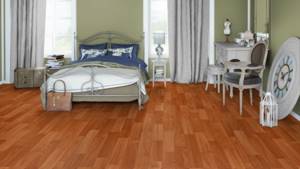
Advantages:
- Reasonable price.
- Does not require special knowledge or effort for installation.
- Waterproof, soundproof and heat insulated.
Flaws:
- Synthetic base.
- To increase its service life, it must be coated with a special mastic.
What is the best linoleum for the bathroom?
Regarding the choice of linoleum for the bathroom, there are the following basic tips that must be strictly followed:
- Choose waterproof linoleum. In the bathroom the humidity is much higher than in other parts of the house/apartment.
- You should definitely choose options with a coating that has ribbed elements. They will protect you from unexpected falls, since linoleum becomes a very slippery surface after water gets in.
- Also choose linoleum that will be resistant to the physical stress of objects pressing on it (washing machine, sink, etc.), and also that will withstand the effects of various detergents.
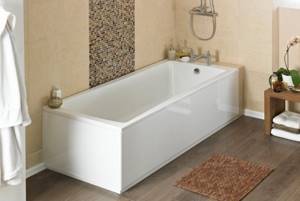
Masters advise using homogeneous coatings in the bathtub.
The best semi-commercial felt-based linoleum
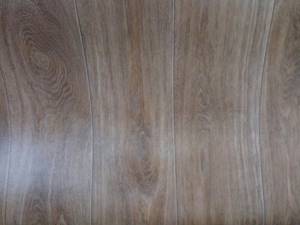
Semi-commercial linoleum from Tarkett Idilia Nova is well suited for all premises. It consists of a protective layer 0.5 mm thick, glued to a felt base.
The thickness of the entire coating is 3.5 mm. It is elastic, soft, pleasant to walk on, and this is the best option for children's rooms.
Advantages:
- First of all, the price is reasonable.
- Soft, warm and pleasant to walk on.
- It has sound insulation and thermal insulation.
Flaws:
- Unstable top layer.
- Can't withstand blows.
- Do not lay in rooms with high humidity.
- Short service life.
Which linoleum is best to lay on a wooden floor?
Perhaps most people experience severe wear and tear on wooden surfaces. This is especially true for gender. Over time, it loses its original appearance, which even careful polishing cannot restore. What to do in this case? The answer is simple - lay linoleum. But the next question arises - which linoleum is best placed on a wooden floor?
For laying on a wooden floor, it is better to choose linoleum with good thermal insulation properties. In combination with wood, this will give an excellent effect and the heat will remain in the room for a long time. As for its options, it all depends on the room in which it will be used, so it’s up to you to decide whether to choose a household, semi-commercial or commercial option.

As for the specifics, fabric-based linoleum is well suited for wooden floors. Also linoleum without a base, which has a uniform structure. Experts also recommend colloxyl linoleum; it is flexible and easy to install, but if the room is not ventilated for several days, a slight chemical smell remains.
The best semi-commercial linoleum for parquet
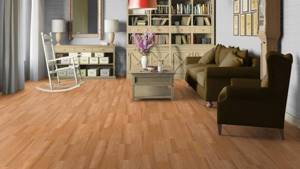
Tarkett Discovery linoleum will visually replace a wooden floor. Its thickness is 3.5 mm and its weight is 2.5 kg.
When choosing a coating, you should pay attention to the markings and meanings of the numbers in the entries:
- The first is in what room it is desirable to use it (2 – residential, 3 – office, 4 – industrial).
- The second is the load withstand.
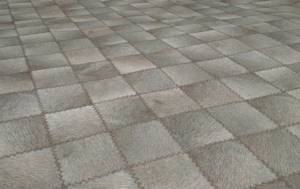
Advantages:
- Reasonable price.
- The coloring completely imitates the texture and structure of a wooden floor.
- Waterproof, thermally insulated and soundproofed.
- Long service life.
Flaws:
- Synthetic base.
- Sometimes it requires coating with a special lubricant.
Marking linoleum for residential premises
According to European standards, linoleum has a certain two-digit marking. The first number characterizes the type of room. The second is the intensity of the load.
The first number is as follows:
- 2 – living quarters.
- 3 – office premises.
- 4 – production premises.
The second number is as follows:
- 1 – low load intensity.
- 2 – average load intensity.
- 3 – high load intensity.
- 4 – very high load intensity.
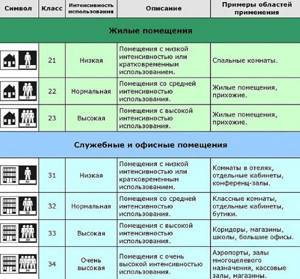
If you choose linoleum, then follow the following markings:
- 21 – premises for short-term use (this includes, for example, bedrooms)
- 22 – linoleum for living rooms, kitchens, children's rooms.
- 23 – linoleum for hallways, corridors and common areas in communal apartments.
These are the main residential markings. After them there are already markings for the numbers 3 and 4. This linoleum is already suitable only for hotels, commercial premises, shops, warehouses, etc.
The best semi-commercial fireproof linoleum

The base of Juteks Trend consists of foamed PVC; linoleum on a felt or jute base is less common. There are groups by which the degree of combustion is determined:
- G1 – slightly flammable.
- G2 – moderately flammable.
- G3 – normally flammable.
- G4 is highly flammable.
Non-flammable flooring is marked G1 and should be used on escape routes.
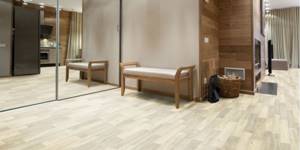
Advantages:
- Non-flammable coating.
- Affordable price.
- Waterproof.
- Requires no effort during installation.
Flaws:
- Synthetic base.
- Sometimes it requires coating with a special mastic.
Details about the disadvantages of PVC
PVC linoleum contains a synthetic polymer – polyvinyl chloride – as a base. To give the material operational properties, the following are added:
- various fillers,
- plasticizers,
- coloring particles that give the most unusual and aesthetic appearance.
The main disadvantage arising from the composition is its synthetic origin.
First of all, this indicates insecurity. That is, during installation and for at least two to three weeks, there will be, to put it mildly, an unpleasant odor. This is due to the release of toxic chemicals.
And the lower-grade and cheaper the linoleum, the more harm it can cause to health. By the way, even the famous Tarkett PVC linoleum emits a pungent odor for several days, although it fully complies with GOST 7251-77.
Secondly, the material is unsafe from the point of view of fire requirements. When ignited, linoleum tends to ignite and burn easily.
The safest samples (often commercial linoleum) have a fire hazard class of KM2, indicating:
- about low flammability (G1),
- flame retardancy (B1),
- low ability to spread flame (RP1).
But at the same time, the toxicity of T2 indicates a moderate danger of combustion products, and the smoke formation of D3+ indicates a high smoke-forming ability.
But most household products are produced with class KM5 and are characterized by:
- highly flammable (G4),
- flammability (B3),
- extreme danger of combustion products (T4),
- high ability to generate smoke (D3).
As soon as the positive temperature reaches the maximum value, such linoleum begins to rapidly spread the flame, as indicated by the RP4 group.
It is highly undesirable to use polyvinyl chloride linoleum for heated floors. If the floor temperature exceeds +28 °C, toxic compounds are released.
The material is also unstable to frequent changes in temperature. A low temperature can cause cracking, while a high temperature will impair elasticity and lead to deformation.
The best regular semi-commercial linoleum
![]()
The most common type of semi-commercial linoleum is Tarkett Force Avatar . It is mainly used in production and at home. There are no traces of furniture left on it.
Thanks to the pattern, which is applied over the entire thickness of the coating, you can inexpensively and efficiently lay a floor over a large area.
Advantages:
- Reasonable price.
- Long service life.
- Suitable for rooms with heavy loads.
- High resistance to wear and tear.
- Waterproof.
- Requires no effort during installation.
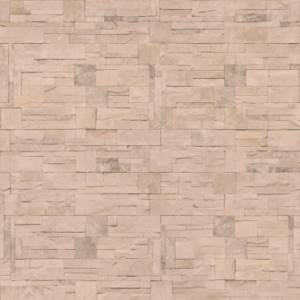
Flaws:
- Synthetic base.
- Requires coating with special lubricant.
Payment methods and delivery
You can buy goods at an affordable price in our online store. Call the number or order a “Call Back”, after which our managers will call you back and answer your questions. Our company independently delivers the goods to the client. Orders over 10 thousand rubles are delivered completely free of charge. Provided the appearance of the product is intact, you can exchange it within 14 calendar days. Guaranteeing product quality at an affordable price has become the basis of our work.
The best insulated semi-commercial linoleum
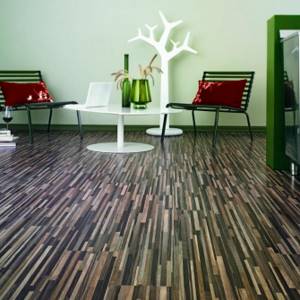
The Trend insulated covering is based on foamed PVC on a felt base, 3 mm thick and with a protective layer of 0.2 mm. It is used in rooms with heavy loads. It leaves no marks from furniture and can withstand impacts.
“Trend” is warm and soft, thanks to these qualities it is pleasant to walk on and can be used in the bedroom.
Advantages:
- Affordable price.
- Warm and pleasant to walk on.
- Does not require much effort during installation.
- Long service life.
Flaws:
- Due to the felt base, it is not advisable to lay it in rooms with high humidity.
- Requires coating with special mastic.
Advertising from sponsors: // // //
Advantages and disadvantages
Of course, to make an appropriate choice, it is best to weigh the pros and cons. Actually, let's start analyzing the issue with the advantages.
- The first thing to note is the endurance of mechanical impact.
- Next - maximum ease of care for the material.
- There is a guarantee that the substance is environmentally safe. So when interacting with this type of linoleum, you don’t have to worry about possible harm to your health.
- Resistance to chemical compounds.
Speaking about the disadvantages of this technology, it is worth noting the following points:
- Not so durable service life.
- A bad choice for use in the home, since the colors of such material are not for everyone.
